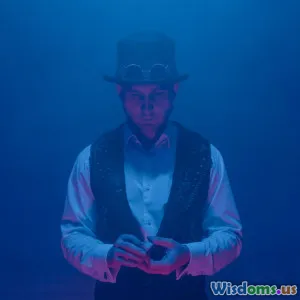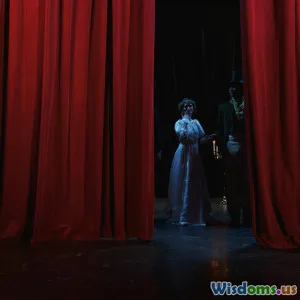
Inside Secrets Escape Artists Never Reveal on Stage
8 min read Explore the guarded secrets escape artists keep from the stage, unlocking the mysteries behind their breathtaking acts. (0 Reviews)
Inside Secrets Escape Artists Never Reveal on Stage
Escape artistry has long captivated audiences worldwide, embodying the allure of mystery, danger, and seemingly impossible triumphs. While performers dazzle with their daring escapes from handcuffs, water tanks, and locked boxes, many of their most fascinating secrets remain tightly under wraps. In this article, we delve behind the curtain to uncover the disciplines, techniques, and hidden truths that escape artists meticulously guard — revealing why some knowledge must never reach the public eye.
The Allure of Escape Artistry
From Harry Houdini to modern masters like David Blaine and Criss Angel, escape artists elevate the craft of illusion by combining physical skill, mental endurance, and showmanship. Their performances are not only feats of dexterity but also tests of nerve, with life-or-death stakes creating palpable tension.
Audiences instinctively want to know how these escapes happen. However, the secrecy surrounding many methods is a crucial element of the craft’s mystique and continued appeal. The question is, why do escape artists maintain such silence on their techniques?
The Hidden Psychology Behind Secrecy
Escape artists operate in a world of trust between performer, audience, and sometimes assistants. Maintaining secrecy nurtures belief and suspense, which are pillars of their performances.
Psychologist Dr. Elizabeth Golden explains, “The unknown fuels awe and wonder. If an escape is fully understood, it loses emotional power. The artist protects their craft by preserving an aura of mystery.”
Moreover, disclosing methods risks the replication of dangerous stunts by untrained persons. Many escape acts have strict safety margins honed through years of practice; improper attempts can be fatal. Artists embrace secrecy not only to protect their careers but also to ensure their methods don’t cause harm.
Dedicated Training and Physical Mastery
Behind every escape lies a rigorously honed combination of strength, flexibility, and precision.
Controlled Breathing and Mental Focus
One insider secret is the artists’ mastery of controlled breathing techniques. Many escapes involve prolonged breath-holding — for instance, underwater escapes where performers can hold their breath for several minutes beyond typical capacity. The physiological conditioning required is intense and dangerous if improperly done.
David Blaine revealed in interviews that he spends hours simulating these conditions, often practicing in deprived air or cold water, quietly training his parasympathetic nervous system to remain calm under stress.
Meticulous Muscle Memory
Escape artists often rely on stripped-down muscle memory honed through repetition. For example, lock paddings or hidden keys might be arranged in ways only the performer understands. Years of practice result in subconscious navigation of mechanisms.
Harry Houdini famously depended on this precision. His escapes depended on finely tuned manipulation of complex locks within seconds — a feat of practice and muscle memory.
Ingenious Props and Customizations
Not all escapes rely solely on physical prowess. Many incorporate cleverly engineered props disguised as standard equipment. These often-forgotten tools are critical.
An example is the use of modified handcuffs with looser tolerances or secret lever releases, indistinguishable from regular restraints to the audience. Some performers collaborate closely with locksmiths or designers to fabricate one-of-a-kind devices that allow freedom within apparent captivity.
Sometimes props include hidden release mechanisms that demand precise timing — another reason exposure could ruin the art.
Orchestrated Distractions and Misdirection
Like magicians, escape artists expertly employ misdirection to divert audience attention from vital movements or mechanisms.
Friendly banter, dramatic music, or sudden gestures create cognitive distractions when a secret release is about to occur. Experienced performers dedicate tremendous effort toward synchronizing their movements with distractions, increasing successful escapes while maintaining audience amazement.
Renowned escape artist Steve Baker remarked, “The stage is half illusion, half physical maneuver. Timing, distractions, and emotional engagement are the invisible threads that weave an escape.”
Real Perils and Risk Management
Despite the appearance of control, each escape carries inherent risks. Most spectators underestimate the danger, assuming it’s all a safe trick.
Historical incidents provide reminders. Houdini nearly drowned during water escapes, and other artists have suffered serious injuries from shackles or fire-related acts.
Today’s performers implement layered safety measures, including concealed assistants and emergency release tools — classified secrets not shared with audiences to preserve suspense. Safety protocols are integral but largely concealed, as revealing them would diminish dramatic tension.
Why Some Secrets Are Never Shared
The magic of escape artistry hinges on mystery. Exposure diminishes awe, endangers performers, and undercuts the intellectual craftsmanship involved.
Pro secrets also serve to protect intellectual property and maintain professional respect; entire careers depend on innovative techniques that distinguish one artist from another.
As illusionist Ricky Jay said, “Secrets are the economy of magic and escape. Without them, the art dissolves into mere demonstration.”
Conclusion: The Enchantment of the Unknown
Escape artistry exemplifies a sublime blend of art, science, and audacity. The secrets held fast by performers are more than just technical tips — they preserve a thrilling dance with peril and perception.
While curiosity tempts audiences to peek behind the curtain, respecting the silent code of escape artistry ensures that future generations continue to thrill to breath-holding, handcuff-breaking wonders.
So next time you witness an escape act, remember: the true magic lies not only in the feat but in the guarded mysteries that make it possible.
References
- Golden, E. (2020). The Psychology of Wonder. Mindspace Publishing.
- Blaine, D. Interviews & Documentaries, Multiple Sources.
- Jay, R. (2011). Secrets and Showmanship: The Art of Magic. Vintage Enchantment Press.
- Houdini, H. (1925). Escape Me Not: Memories of a Dream. Classic Illusion Library.
Rate the Post
User Reviews
Popular Posts



















